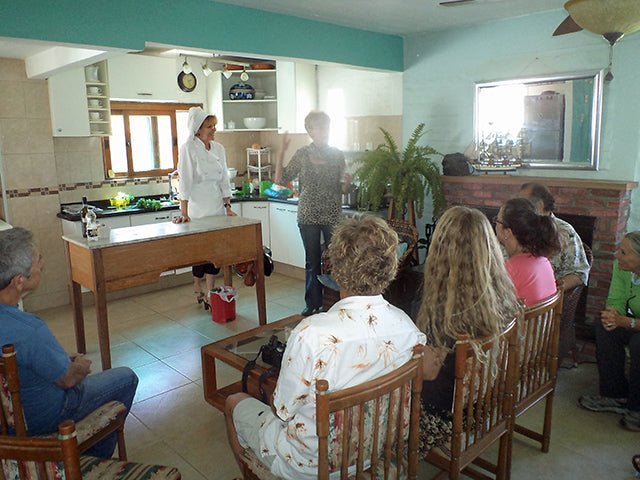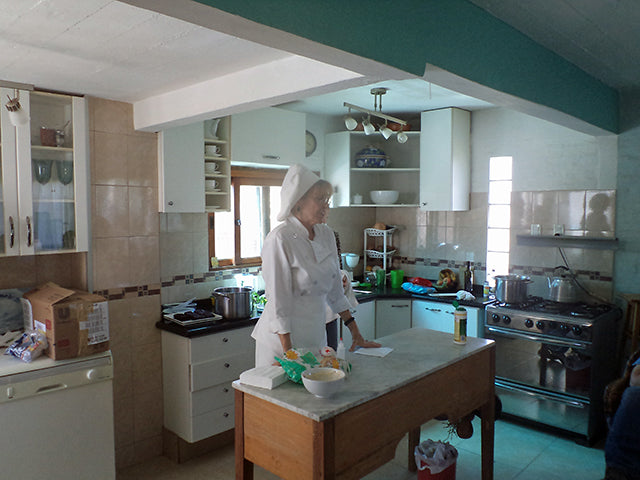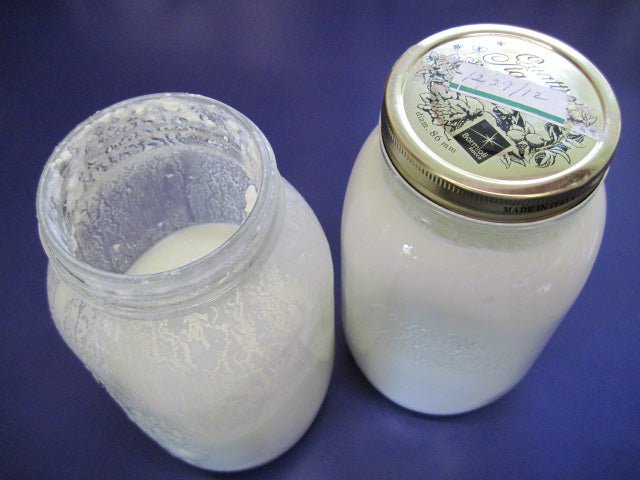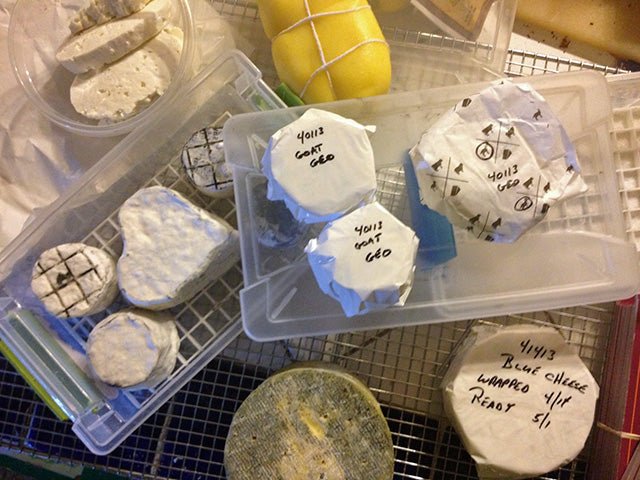 |
| Chef Nancy and Karl Falster getting ready to “fire up” their earth oven |
Raising mini-cattle, making cheese and teaching a workshop in Uruguay – this is one busy lady!
Chef Nancy Falster and her husband, Karl of Falster Farms in Winnsboro, Texas raise miniature Herefords and sell the beef (along with pastured pork and chicken). If you aren’t familiar with the joys of raising mini-cows, check out the FAQ page of their website. They are dedicated to answering all your questions by phone and e-mail.
Nancy is a personal chef, cooking in the style promoted by the Weston A. Price Foundation in Sally Fallon’s wonderful cookbook “Nourishing Traditions.” While creating three meals a day for her husband and their apprentices, she cooks for private clients, as well.
She also teaches cheese making classes and, in fact, she was Rashel Harris’s first teacher. (Rashel is a master home cheese maker who has produced many educational YouTube videos – ThePromiselandFarm.)
Gerry took pictures of the class in Uruguay and sent them to Karl who wrote this lovely description of the experience:
Chef Nancy Teaching in Uruguay
By Karl Falster
In a land far, far away on Super Bowl Sunday, Chef Nancy of Falster Farm (www.falsterfarm.com) met with a house-full of nice folks who wanted to learn how to make cheese. Chef Nancy was invited to Piriapolis, Uruguay visiting with dear friends, Joe and Susan who set up an opportunity for her to demonstrate making Mozzarella and Ricotta cheese.
Sharon and Gerry Rhodes hosted the class in their delightful open and airy home where all could see and be up close to the action.
The supplies were brought from the states in Chef Nancy’s suitcase and came from New England Cheesemaking Company. She had calcium chloride, citric acid and animal rennet. She used some Kosher salt at her hosts home. Also, purchased locally at the farmer’s market was the basil used with the fresh cheese.
A new yard thermometer was put into use to get the temperature right…sometimes chefs have to ‘go with the flow’ and this worked just fine.
Before the milk was heated, chef Nancy added the citric acid, then at the proper temperature she added the rennet.
She demonstrated how the milk begins to clump together and had the class all come up and stir and feel the changes going on. Then she brought the heat up so the curds would begin their coagulating. This is when she noticed the curds were not getting stretchy…hmmm, what could be the problem?
One of the guests asked what brand of local milk had been purchased and chef Nancy got out the plastic bag which all the milk comes in and the gal said that brand is known to have hormones to it and that may very well be the issue but Chef Nancy did not let that stop her from showing these folks how to make cheese! She worked with what she had.
Because of the crumbly nature of the curd, she poured them through a cheese cloth and to pick up every bit and to clean the whey..
She gathered up the curds into the cloth and gently pressed so the curds would begin to form a solid mass. It was obvious that whatever had been added to the milk was going to keep it from becoming soft and stretchy but that did not mean chef Nancy could not make cheese…
She worked with the lump and kept dipping it into the hot whey ( she continued to heat it up to the correct temperature ) until she was able to work it into a ball – even if not a smooth, shiny one.
She explained what the cheese usually looks like at this stage and how it should be able to be stretched into a long, smooth rope…
Oh well, she dipped it again into the hot whey and placed it on the bar and worked the cheese salt into the mass and then after another dip in the whey to re-heat, she spread it into the dish to shape it.
Susan helped by cutting the cheese into bites for all to taste after adding a splash of Balsamic vinegar and fresh basil. Even if it was not very pretty, it tasted good and all had a taste and plan on trying their hand at making their own. While they were enjoying the fresh cheese, Chef Nancy started on the Ricotta. Slowly bringing up the temperature she shows the small grains separating after vinegar is added to the hot whey.
The guests realized that this cheese might be affected by chemical additives also. It took several hours for the cheese to ‘finish’ enough to be poured through a cheese cloth and then have the soft ricotta scraped into a bowl, but it was also very good and was used in an appetizer that evening.
While the class was waiting for the ricotta to heat up, Chef Nancy answered questions and surprised the interested students with a couple of other snacks using kefir.
One was a chocolate cake made by Susan using kefir cream* instead of buttermilk which is not readily available in Uruguay. This rich, velvety dessert went so fast, we did not get a picture of it.
Chef Nancy also made a spicy dip with kefir cream and local spices that was enjoyed on crackers.
It was a fun group and no one seemed to mind that the cheeses did not turn out as planned. This was a good thing in fact because it helped to reiterate chef Nancy’s admonishing the group to try the cheese and don’t worry if it is not like what is found on grocery store shelves- we would have all missed out on a great afternoon of learning and good eating if we had stopped when the first “uh-oh” showed up.
There are many recipes for making Mozzarella, the important thing is to get your ingredients from a reputable company like New England Cheesemaking Company and get started!
* Note from Chef Nancy: The kefir was made from whipping cream…oh, so good. All the dairy (in Uruguay) is put in bags for retail sales, so Susan bought a bag of heavy whipping cream- poured it into a jar, added two big globs from the last batch of kefir cream and let it sit out until it turned thick and separated, just like kefir. Then she repeated like she has done for over two years when Nancy brought Susan and Joe their first batch of kefir as a hostess gift.



























































































































































